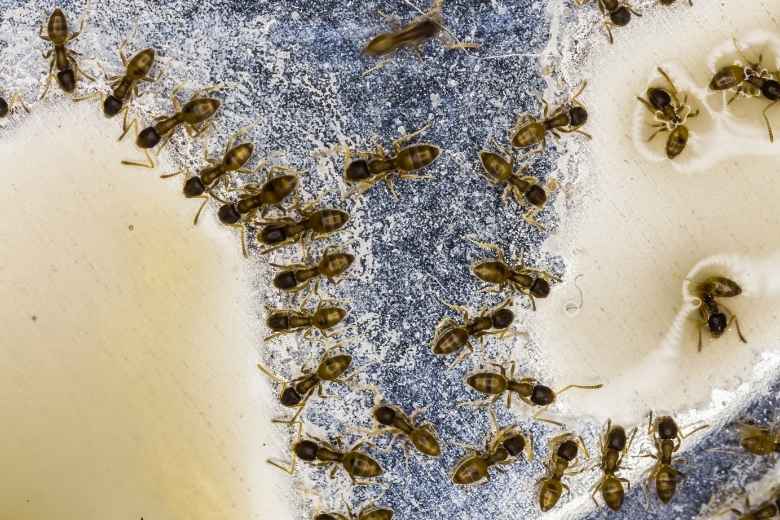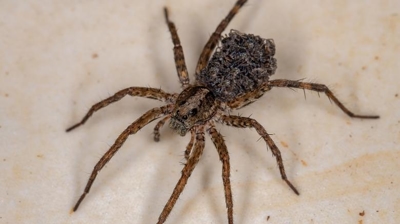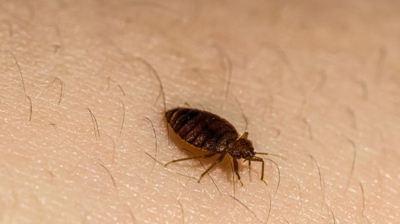
Thief Ants

Are Thief Ants Harmful?
Thief ants (Solenopsis molesta), also known as grease ants, house ants, or tiny yellow ants, are not directly harmful in the sense that they bite or sting humans aggressively or transmit major diseases. However, these ants are considered harmful pests due to their potential to contaminate food, their difficult-to-control infestations, and the environments in which they tend to be active—especially in sensitive locations like hospitals, food processing areas, restaurants, and homes.
- Food Contamination: Thief ants readily invade kitchens and pantries, feeding on greasy, protein-rich, and oily foods, as well as sweets. They can infiltrate sealed food packaging due to their incredibly small size. As they travel through unsanitary areas (e.g., garbage, dead insects, drains), they can contaminate food, utensils, and preparation surfaces.
- Health Risk Potential: While they do not transmit diseases in the way that cockroaches or rodents might, their movement across unsanitary areas poses a risk of spreading pathogens indirectly. In healthcare settings, this contamination risk becomes a serious concern, especially around sterile environments, wounds, or immunocompromised patients.
- Persistent and Invasive: They form large colonies with multiple queens, which means that infestations can grow quickly. If disturbed (such as by improper pesticide use), colonies can bud or split into new satellite colonies, making them even harder to eliminate. Thief ants often nest inside wall voids, behind baseboards, or inside insulation, making them hard to detect and treat without specialized equipment and knowledge.
- Industrial and Commercial Threat: In food processing facilities, thief ants can cause product recalls or regulatory violations. In restaurants, they can cause failed inspections and customer complaints. In hospitals and care facilities, their presence can compromise sanitation protocols and damage the institution’s reputation.
While thief ants don’t pose a direct medical threat like fire ants or wasps, they are harmful as a contaminant pest and extremely invasive due to their size, reproductive strategy, and nesting preferences.
Learn more: Do Thief Ants Bite? || What Do Thief Ants Eat?
Thief Ant Removal
Thief ants may look tiny and harmless, but they’re one of the more problematic ant species to leave untreated. Here’s why eliminating them is so important:
- They spread quickly and are hard to control: Thief ants create multiple small nests connected by tunnels, often inside wall voids, foundations, and insulation. Because they’re so small—often called grease ants—they slip through microscopic cracks that most other ants can’t. A small colony can turn into a building-wide problem in a short time.
- They contaminate food easily: Their preferred diet is protein, fats, and sugary foods. Once they gain access to a kitchen or pantry, they can contaminate stored goods, food preparation surfaces, and ingredients. Their tiny size lets them infiltrate sealed packaging that other pests can’t breach.
- They can spread pathogens: While they don’t sting, thief ants forage in unsanitary places like garbage, drains, and dead insects. They can pick up bacteria and transfer it onto countertops, food items, pet dishes, and utensils.
- They raid other insect nests: Thief ants steal eggs, larvae, and food from nearby ant species. That behavior often forces competing pests—like larger ant species—to relocate or spread further into the structure, indirectly worsening the overall pest pressure.
Because of their nesting habits and size, standard over-the-counter ant baits often fail. If the bait doesn’t match their nutritional needs at the moment (they switch preferences), they will ignore it. Even when they do take bait, their complex, dispersed colonies make elimination difficult without our professional materials and strategy.
Learn more: How To Get Rid Of Thief Ants
Thief Ant Control
Hiring our professional pest control for thief ants is the most effective way to eliminate them because these ants are especially difficult to detect and control. Thief ants are extremely small, often entering homes through cracks and crevices, and they typically nest in hidden areas or close to other ant colonies. Their secretive behavior makes them hard to locate without specialized training and equipment.
DIY methods such as sprays or over-the-counter baits usually fail because thief ants prefer protein- and grease-based foods, meaning most standard sugar-based baits won’t attract them. Even if they do take the bait, improper placement can cause colonies to split and spread further. Our professionals understand thief ant biology and use targeted treatments with the correct type of bait and application methods to ensure the entire colony is eliminated.
Additionally, our professionals don’t just treat the visible problem—they identify entry points, nesting sites, and conditions that attract these ants, helping to prevent future infestations. This not only saves you time and frustration but also protects your home or business from repeat outbreaks.
Thief Ant Exterminators
Hiring our local exterminator for thief ants often provides far better results than going with a national company:
- Expertise with local pest behavior: Our local exterminators have experience with the specific ant species and pest pressures common in your area. Thief ants can nest differently depending on climate, building materials, and available food sources. Ou local pros understand the typical hiding spots—wall voids, insulation, under baseboards, and even inside electrical outlets—that a nationwide service might overlook.
- Faster, more tailored response: Our local exterminators can respond quickly, often the same day or within 24 hours. Thief ants spread fast, so timing is crucial. National chains may require scheduled visits weeks out, giving the colony more time to grow and disperse.
- Customized treatment plans: Rather than using a one-size-fits-all treatment, our local exterminators assess the property and create a targeted plan. This might include baiting strategies matched to the ants’ current dietary preference, crack-and-crevice treatments, and monitoring to ensure complete eradication. National companies often rely on generic protocols that may not address the nuances of your specific infestation.
- Ongoing support and accountability: Our local exterminators are invested in our reputation in the community. We provide follow-up visits and adjust treatments as needed until the problem is fully resolved. National companies may have higher turnover of technicians and less personal follow-up, making it easier for small colonies to survive undetected.
- Knowledge of building-specific challenges: Our local pros know the common construction styles, plumbing layouts, and other structural factors in the area that influence how ants enter and move. This insight allows for more precise sealing, bait placement, and preventive strategies.
With thief ants’ tiny size, hidden nests, and ability to multiply quickly, hiring our local exterminators increases the odds of fully eliminating the infestation quickly and preventing reoccurrence—something a national chain’s standard protocol often can’t guarantee.
Thief Ant Solutions
Our exterminators use Integrated Pest Management (IPM) to control thief ants because these ants are extremely small, form multiple satellite colonies, and often nest near or inside the nests of other ant species, making them difficult to eliminate with conventional sprays. IPM begins with a detailed inspection to locate nesting sites, foraging trails, and environmental factors that attract the ants, such as food sources and moisture. Treatment strategies rely heavily on targeted baits that worker ants transport back to the colony to reach the queen and brood, combined with habitat modification, including sealing entry points, improving sanitation, and reducing moisture. Physical exclusion and regular monitoring help track activity and ensure treatments are effective without unnecessary pesticide use. By emphasizing precise, long-term control and minimal environmental impact, IPM provides a professional and sustainable solution for managing thief ant populations.
What Do Thief Ants Look Like?
Thief ants, also known as Solenopsis molesta, are among the smallest ant species you’ll encounter, which makes them easy to overlook. Adult workers typically measure only about 1.5 to 2.2 millimeters in length—roughly the size of a pinhead. Their color ranges from yellow to light brown, sometimes appearing almost translucent in certain lighting. Distinctive features include:
- Body shape: Slender and smooth with a two-segmented “waist” (petiole) between the thorax and abdomen.
- Head: Tiny, rounded, and equipped with short antennae that have 10 segments, ending in a two-segmented club.
- Mandibles: Small and relatively weak compared to larger ants, because they primarily steal food from other colonies rather than hunt.
- Behavioral traits: They often nest near or inside the colonies of larger ants, sneaking into their nests to steal food or brood (larvae and pupae).
Because of their size and light color, they are frequently mistaken for pharaoh ants, but thief ants are slightly smaller and tend to infest dry, protected areas like inside walls, under floors, or in small food crumbs. Unlike more aggressive ants, they rarely forage in large visible trails, making their presence harder to detect.
Where Are Thief Ants Found?
Thief ants (Solenopsis molesta) are widely distributed throughout the United States, especially in the eastern, central, and southern regions, but they are also found in many parts of North, Central, and South America. Their adaptability allows them to thrive in both indoor and outdoor environments, making them a common nuisance in homes, commercial kitchens, food storage facilities, and healthcare settings.
Indoors
Thief ants are notorious for exploiting the tiniest gaps to enter buildings in search of food, water, and shelter. Common indoor sites include:
- Kitchens and pantries: Often found trailing along countertops, under sinks, behind baseboards, and in cabinets, particularly near grease or protein-rich foods.
- Wall voids and electrical outlets: They nest in undisturbed areas like behind walls, under flooring, in insulation, and inside wall sockets.
- Bathrooms and plumbing voids: Moisture-attracting areas such as under bathtubs or sinks provide ideal harborage.
- Appliances and electronics: Their small size allows them to crawl into microwaves, coffee makers, printers, and other warm, tight spaces.
Outdoors
Outdoors, thief ants nest in protected, hidden environments that are close to food sources and sometimes near other ant colonies:
- Under rocks, logs, and landscape mulch
- In soil cracks, especially around foundations and walkways
- Under loose bark or within rotting wood
- Inside decaying logs or hollow twigs
- Near the nests of other ant species – where they earn their name by raiding other colonies to steal brood (larvae and pupae).
Environmental Preferences
- Temperature: They prefer warm conditions and are most active during the summer, but indoor infestations may occur year-round.
- Moisture: While they can tolerate dry areas, they are often found near moisture sources (e.g., sinks, leaky pipes, irrigation systems).
- Urban/Suburban Settings: Particularly common in densely populated areas due to the abundance of food and shelter.
Geographic Range
- United States: Common across much of the country, with highest prevalence in warmer regions like the South, Midwest, and Eastern states.
- Global Distribution: While most prevalent in the Americas, related Solenopsis species are found worldwide. However, Solenopsis molesta is mostly a North and Central American issue.
Thief Ant Life Cycle
The life cycle of thief ants (Solenopsis molesta) follows a complete metamorphosis, progressing through four distinct stages: egg, larva, pupa, and adult:
Egg Stage
- Appearance: Eggs are minute, white, and oval-shaped—barely visible to the naked eye.
- Laid by: One or multiple queens (polygynous colonies are common in thief ants).
- Duration: Eggs typically hatch in 4 to 5 days, depending on temperature and humidity.
Larval Stage
- Feeding Stage: Larvae are legless, white, and grub-like. They rely entirely on adult worker ants for food.
- Diet: Larvae are fed regurgitated, pre-digested food by worker ants—primarily proteins and lipids.
- Duration: The larval stage lasts 7 to 10 days under favorable conditions.
Pupal Stage
- Transition Phase: Larvae spin a cocoon in which they transform into pupae. During this time, they undergo significant morphological changes to become adult ants.
- Appearance: Thief ant pupae are naked (i.e., they do not spin protective cocoons) and resemble adult ants but are pale and immobile.
- Duration: The pupal stage typically lasts 10 to 12 days, again depending on the environment.
Adult Stage
Caste Differentiation:
- Workers: Sterile females that perform all foraging, brood care, and colony maintenance.
- Queens: Fertile females responsible for laying eggs. Colonies often have multiple queens.
- Males (drones): Fertile males whose sole purpose is to mate with queens during nuptial flights.
Lifespan:
- Workers: Live several weeks to a few months.
- Queens: Can live a year or more, continuing to reproduce.
- Males: Live only a short time after mating.
Colony Development and Growth
- Initial Colony Establishment: After a mating flight, a newly mated queen seeks a nesting site and begins laying eggs.
- Colony Maturation: Colonies can grow rapidly due to the short developmental time (around 3–4 weeks from egg to adult) and the presence of multiple queens.
- Population: A mature colony may contain several thousand workers, though colony size is often smaller compared to more aggressive species like fire ants.
Reproductive Swarming (Nuptial Flights)
- Thief ants do reproduce via nuptial flights like other ant species, but they are rarely observed because they often occur indoors or under cover.
- After mating, females lose their wings and start new colonies—either independently or by budding (splitting off from the main colony with a group of workers), which increases their potential for rapid spread in structures.

Hear From Our Happy Customers
-
"Great Communication"
Tech was on time, communication was great, and he accommodated my needs.
- Alonzo W. -
"Wonderful Service"
Wonderful service. Jarvis is great. Took care of everything I needed. Thank you!
- Henry P. -
"Very Knowledgeable"
The tech that arrived was courteous, professional, and very knowledgeable. He was Great.
- Uerial I. -
"Fantastic & Patient"
Jarvis was fantastic and patient. He answered my questions with an in-depth explanation and addressed all of my areas of concern. Would love for him to be my assigned tech going forward. Well done!
- Yonnette M. -
"Professional & Considerate"
I’m pleased with Miche services. Jarvis came today. Professional and considerate. Thank you!
- Judy B. -
"Exceeds Expectations"
I can’t say enough positive things about this company... The tech that came out, Jarvis went above and beyond my expectations. Thank you guys, I will continue using your services.
- Jake M.



